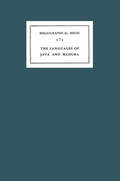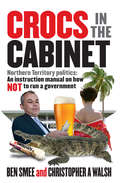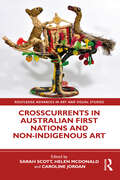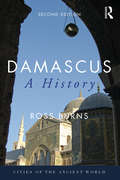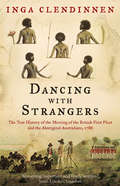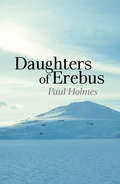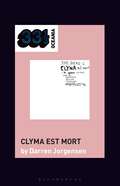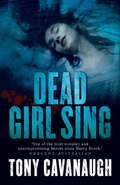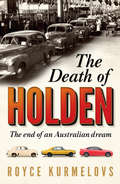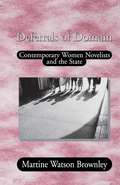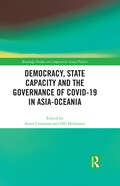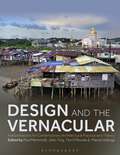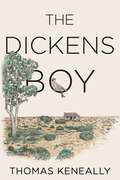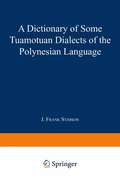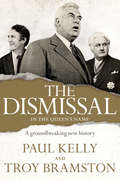- Table View
- List View
A Critical Survey of Studies on the Languages of Java and Madura: Bibliographical Series 7 (Koninklijk Instituut voor Taal-, Land- en Volkenkunde #3)
by E.M. UhlenbeckAt the completion of this critical bibliography which forms another step in the direction of the realization of the bibliographical project inaugurated in 1955 by Dr. Voorhoeve's survey of the languages of Sumatra, I acknowledge with gratitude the valuable assistance received from various people. I am indebted to my colleagues Prof. Dr. G. W. J. Drewes, Dr. J. Noorduyn, Dr. Th. Pigeaud, Prof. Dr. A. Teeuw and Dr. P. Voorhoeve, who read all or part of the manuscript and who generously put their extensive knowledge of the Java languages at my disposal. Heartfelt thanks are due to Mr. B. J. Hoff and Mr. A. G. Sciarone, both members of my staff, who verified many of the biblio graphical details. I am grateful to the library of the University of Leiden and to the library of the Institute in The Hague because of their readiness in giving me all the facilities I needed for the preparation of this book. Most useful was the cordial assistance received from my colleague Prof. Dr. P. E. de Josselin de Jong, who spent much time correcting the many imperfections of my English text, which greatly promoted the readability of the narrative sections of this survey.
Crocs in the Cabinet: Northern Territory politics – an instruction manual on how NOT to run a government
by Ben Smee Chistopher A WalshGoings-on in Northern Territory politics from 2012-2016 may read like satire, but it is all true. These are stories you couldn't make up. This book is an instruction manual on how NOT to run a government.In the Top End, politics is not a numbers game, it is a blood sport.In comparison to Rudd, Gillard, Abbott and Turnbull, the goings-on in the Northern Territory parliament are like watching a troop of clowns throwing knives into each other's backs.CROCS IN THE CABINET is partly a serious political book, partly a riotous look at the characters, the scandals and the incompetence of Northern Territory politics. It will make you laugh, cry, wince and shake your head as you read of:- a minister with a hostess club bill- a masturbating minister and the lewd videos he sent someone other than his wife- why a minister shouted 'we are in love' on the floor of the parliament- how the Chief Minister stared down a coup- how an MP forced the evacuation of a hotel- why an MP went fishing instead of dealing with leadership matters- exactly how bonkers the NT parliament really is.Written by two of the NT NEWS's best journalists, Walkley Award-winning Ben Smee and award-winning Christopher A. Walsh, this is FEAR AND LOATHING ON THE CAMPAIGN TRAIL meets FAWLTY TOWERS.
Crosscurrents in Australian First Nations and Non-Indigenous Art (Routledge Advances in Art and Visual Studies)
by Sarah Scott Helen McDonald Caroline JordanThis edited collection examines art resulting from cross-cultural interactions between Australian First Nations and non-Indigenous people, from the British invasion to today. Focusing on themes of collaboration and dialogue, the book includes two conversations between First Nations and non-Indigenous authors and an historian’s self-reflexive account of mediating between traditional owners and an international art auction house to repatriate art. There are studies of ‘reverse appropriation‘ by early nineteenth-century Aboriginal carvers of tourist artefacts and the production of enigmatic toa. Cross-cultural dialogue is traced from the post-war period to ‘Aboriginalism’ in design and the First Nations fashion industry of today. Transculturation, conceptualism, and collaboration are contextualised in the 1980s, a pivotal decade for the growth of collaborative First Nations exhibitions. Within the current circumstances of political protest in photographic portraiture and against the mining of sacred Aboriginal land, Crosscurrents in Australian First Nations and Non-Indigenous Art testifies to the need for Australian institutions to collaborate with First Nations people more often and better. This book will appeal to students and scholars of art history, Indigenous anthropology, and museum and heritage studies.
Crosscurrents in Australian First Nations and Non-Indigenous Art (Routledge Advances in Art and Visual Studies)
This edited collection examines art resulting from cross-cultural interactions between Australian First Nations and non-Indigenous people, from the British invasion to today. Focusing on themes of collaboration and dialogue, the book includes two conversations between First Nations and non-Indigenous authors and an historian’s self-reflexive account of mediating between traditional owners and an international art auction house to repatriate art. There are studies of ‘reverse appropriation‘ by early nineteenth-century Aboriginal carvers of tourist artefacts and the production of enigmatic toa. Cross-cultural dialogue is traced from the post-war period to ‘Aboriginalism’ in design and the First Nations fashion industry of today. Transculturation, conceptualism, and collaboration are contextualised in the 1980s, a pivotal decade for the growth of collaborative First Nations exhibitions. Within the current circumstances of political protest in photographic portraiture and against the mining of sacred Aboriginal land, Crosscurrents in Australian First Nations and Non-Indigenous Art testifies to the need for Australian institutions to collaborate with First Nations people more often and better. This book will appeal to students and scholars of art history, Indigenous anthropology, and museum and heritage studies.
The Cruise of the Snark
by Jack LondonThe Cruise of the Snark (1911) is a memoir of Jack and Charmian London''s 1907-1909 voyage across the Pacific. His descriptions of surf-riding, which he dubbed a royal sport, helped introduce it to and popularize it with the mainland. London writes: Through the white crest of a breaker suddenly appears a dark figure, erect, a man-fish or a sea-god, on the very forward face of the crest where the top falls over and down, driving in toward shore, buried to his loins in smoking spray, caught up by the sea and flung landward, bodily, a quarter of a mile. It is a Kanaka on a surf-board. And I know that when I have finished these lines I shall be out in that riot of colour and pounding surf, trying to bit those breakers even as he, and failing as he never failed, but living life as the best of us may live it. . from Wikipedia, The Free Encyclopedia. Intuitive navigation. . Text annotation and mark-up. .
Damascus: A History (Cities of the Ancient World)
by Ross BurnsDamascus, first published in 2005, was the first account in English of the history of the city, bringing out the crucial role it has played at many points in the region’s past. It traces the story of this colourful, significant and complex city through its physical development, from the its emergence in around 7000 BC through the changing cavalcade of Aramaean, Persian, Greek, Roman, Byzantine, Arab, Turkish and French rulers to independence in 1946. This new edition has been thoroughly updated using recent scholarship and includes an additional chapter placing the events of the Syrian post-2011 conflict in the context of the city’s tumultuous experiences over the last century. This volume is a must-read for anyone interested in the sweep of Syrian history and archaeology, and is an ideal partner to Burns’ Aleppo (2016). Lavishly illustrated, Damascus: A History remains a unique and compelling exploration of this fascinating city.
Damascus: A History (Cities of the Ancient World)
by Ross BurnsDamascus, first published in 2005, was the first account in English of the history of the city, bringing out the crucial role it has played at many points in the region’s past. It traces the story of this colourful, significant and complex city through its physical development, from the its emergence in around 7000 BC through the changing cavalcade of Aramaean, Persian, Greek, Roman, Byzantine, Arab, Turkish and French rulers to independence in 1946. This new edition has been thoroughly updated using recent scholarship and includes an additional chapter placing the events of the Syrian post-2011 conflict in the context of the city’s tumultuous experiences over the last century. This volume is a must-read for anyone interested in the sweep of Syrian history and archaeology, and is an ideal partner to Burns’ Aleppo (2016). Lavishly illustrated, Damascus: A History remains a unique and compelling exploration of this fascinating city.
Dancing With Strangers: The True History of the Meeting of the British First Fleet and the Aboriginal Australians, 1788
by Inga ClendinnenIn January of 1788 the First Fleet arrived in New South Wales and a thousand British men and women encountered the people who will be their new neighbours; the beach nomads of Australia. "These people mixed with ours," wrote a British observer soon after the landfall, "and all hands danced together." What followed would determine relations between the peoples for the next two hundred years. Drawing skilfully on first-hand accounts and historical records, Inga Clendinnen reconstructs the complex dance of curiosity, attraction and mistrust performed by the protagonists of either side. She brings this key chapter in British colonial history brilliantly alive. Then we discover why the dancing stopped . . .
Daughters of Erebus
by Paul HolmesHow 287 people died in the air crash on Mt Erebus. What caused the crash and who covered it up
The Dead C’s Clyma est mort (33 1/3 Oceania)
by Darren JorgensenThe Dead C's Clyma est mort (1993) is the record of a live gig for one person. Tom Lax was running the Siltbreeze label in Philadelphia and had come to New Zealand to meet the artists he was releasing. He heard The Dead C at their noisy, improvised best, turning rock music on its head with a free-form style of blaring, loosely organised sound. Leading a second wave of music from Dunedin, New Zealand, The Dead C were an assault against the kind of jangly pop that had made the Dunedin Sound famous during the 1980s. This book uses The Dead C and in particular their album Clyma est mort (1993) to offer insights into the way the best of rock music plays vertigo with our senses, illustrating a sonic picture of freedom and energy. It places the album into the history of independent music in New Zealand, and into an international context of independent labels posting, faxing and phoning each other.
The Dead C’s Clyma est mort (33 1/3 Oceania)
by Darren JorgensenThe Dead C's Clyma est mort (1993) is the record of a live gig for one person. Tom Lax was running the Siltbreeze label in Philadelphia and had come to New Zealand to meet the artists he was releasing. He heard The Dead C at their noisy, improvised best, turning rock music on its head with a free-form style of blaring, loosely organised sound. Leading a second wave of music from Dunedin, New Zealand, The Dead C were an assault against the kind of jangly pop that had made the Dunedin Sound famous during the 1980s. This book uses The Dead C and in particular their album Clyma est mort (1993) to offer insights into the way the best of rock music plays vertigo with our senses, illustrating a sonic picture of freedom and energy. It places the album into the history of independent music in New Zealand, and into an international context of independent labels posting, faxing and phoning each other.
Dead Girl Sing (The Darian Richards Series #2)
by Tony Cavanaugh'One of the most complex and uncompromising heroes since Harry Bosch' - Weekend AustralianWorld-class crime writing from a brilliant Australian author.Darian Richards knew he should have let the phone keep ringing. But more than two decades as a cop leaves you with a certain outlook on life. No matter how much he tried to walk away, something, or someone, kept bringing him back to his gun.One phone call. Two dead girls in a shallow water grave. And a missing cop to deal with. Something bad is happening on the Gold Coast glitter strip. Amongst the thousands of schoolies and the usual suspects, someone is preying on beautiful young women. No one has noticed. No one knows why.Darian looked into the eyes of those two dead girls. The last person to do that was their killer. He can't walk away. He will find out why.Tony Cavanaugh is an Australian writer and producer of film and television with over thirty years' experience in the industry. Dead Girl Sing is his second book featuring former cop Darian Richards and follows on from the acclaimed crime thriller Promise.The Darian Richards SeriesPromiseDead Girl SingThe Soft Touch (Short Story)The Train RiderKingdom of the Strong
The Death of Holden: The bestselling account of the decline of Australian manufacturing
by Royce KurmelovsHolden is one of the few brands that has an emotional grip on Australia (Qantas being another). The closure of the Holden factory in Adelaide is not just the end of a business - it's the end of an era, of a story, and of a great Australian dream.When Holden signalled that it would close its Adelaide factory, it struck at the very heart of Australian identity. Holden is our car made on our shores. It's the choice of patriotic rev heads and suburban drivers alike. How could a car that was so beloved - and so popular - be so unprofitable to make?The story of the collapse of Holden is about the people who make and drive the cars; it's about sustaining industry in Australia; it's about communities of workers and what happens when the work dries up. And if it's not quite about the death of an icon - because Holdens will remain on Australian roads for a long time to come - then it's about what happens when an icon falls to knees in front of a whole nation.'Brilliant and powerful' Nick Xenophon
Decolonising Australian History Education: Fresh Perspectives from Beyond the ‘History Wars’
by Rebecca Cairns Sara Weuffen Aleryk FrickerThis book is the first of its kind to showcase a range of fresh and expert perspectives on decolonising history education in Australia. The research-informed chapters by First Nations and non-Indigenous educators and scholars provide guidance on applying practical strategies for decolonising learning and teaching, and moving beyond the ‘history wars’.History has long been the most contentious area of education in Australia. This book tackles the narrow and overtly politicised ‘history wars’ debates and foregrounds the need to re-examine impacts of settler-colonialism on Australia’s history. First-hand knowledge and much-needed teaching practices are presented, demonstrating how decolonisation can be put into action through Australian history education. The chapters present a range of perspectives from the early years right through to higher education settings and argues that there is an increased need for greater awareness, appreciation, and willingness to explore and engage with multiple narratives of truth-telling that are so often contested. Readers are guided to discover how this translates to classroom practice through unique, provocative, and research-informed strategies that foreground applied decolonising approaches.Combining theoretical perspectives and practical ideas, this book is an essential resource to support pre- and in-service teachers, in all education contexts, in navigating the decolonisation of Australian history education. This makes it an important contribution to local, as well as global, decolonising efforts.
Decolonising Australian History Education: Fresh Perspectives from Beyond the ‘History Wars’
by Rebecca Cairns Sara Weuffen Aleryk FrickerThis book is the first of its kind to showcase a range of fresh and expert perspectives on decolonising history education in Australia. The research-informed chapters by First Nations and non-Indigenous educators and scholars provide guidance on applying practical strategies for decolonising learning and teaching, and moving beyond the ‘history wars’.History has long been the most contentious area of education in Australia. This book tackles the narrow and overtly politicised ‘history wars’ debates and foregrounds the need to re-examine impacts of settler-colonialism on Australia’s history. First-hand knowledge and much-needed teaching practices are presented, demonstrating how decolonisation can be put into action through Australian history education. The chapters present a range of perspectives from the early years right through to higher education settings and argues that there is an increased need for greater awareness, appreciation, and willingness to explore and engage with multiple narratives of truth-telling that are so often contested. Readers are guided to discover how this translates to classroom practice through unique, provocative, and research-informed strategies that foreground applied decolonising approaches.Combining theoretical perspectives and practical ideas, this book is an essential resource to support pre- and in-service teachers, in all education contexts, in navigating the decolonisation of Australian history education. This makes it an important contribution to local, as well as global, decolonising efforts.
Deferrals of Domain: Contemporary Women Novelists and the State
by NA NAContemporary female novelists tend to portray the relationship between women and the state as profoundly negative, in contrast to various constructions in current feminist theory. Martine Watson Brownley analyzes novels by Margaret Atwood, Paule Marshall, Nadine Gordimer, and Margaret Drabble to explore the significance of this disparity. The book uses literary analysis to highlight elements of state power that many feminist theorists currently occlude, ranging from women's still minimal access to state politics to the terrifying violence exercised by modern states. At the same time, however, feminist theory clarifies major elements in many contemporary women's lives about which the novels are ambivalent or misleading, such as romantic love and the role of sexuality in state politics. Deferrals of Domain fills a double gap, both authorial and topical, in current critical treatments of women writers and will be of interest to both literary and women's studies scholars.
Democracy, State Capacity and the Governance of COVID-19 in Asia-Oceania (Routledge Studies on Comparative Asian Politics)
by Aurel Croissant Olli HellmannThis book examines the public health responses to the COVID-19 pandemic in the Asia-Oceania region and their implications for democratic backsliding in the period January 2020 to mid-2021. The contributions discuss three key questions: How did political institutions in Asia-Oceania create incentives for effective public health responses to the COVID-19 outbreak? How did state capacities enhance governments’ ability to implement public health responses? How have governance responses affected the democratic quality of political institutions and processes? Together, the analyses reveal the extent to which institutions prompted an effective public health response and highlights that a high-capacity state was not a necessary condition for containing the spread of COVID-19 during the early phase of the pandemic. By combining quantitative and qualitative analyses, the volume also shows that the effect of the COVID-19 pandemic on the quality of democratic institutions has been uneven across Asia-Oceania. Guided by a comprehensive theoretical framework, this will be an invaluable resource for scholars and students of political science, policy studies, public health and Asian studies.
Democracy, State Capacity and the Governance of COVID-19 in Asia-Oceania (Routledge Studies on Comparative Asian Politics)
by Aurel Croissant Olli HellmannThis book examines the public health responses to the COVID-19 pandemic in the Asia-Oceania region and their implications for democratic backsliding in the period January 2020 to mid-2021. The contributions discuss three key questions: How did political institutions in Asia-Oceania create incentives for effective public health responses to the COVID-19 outbreak? How did state capacities enhance governments’ ability to implement public health responses? How have governance responses affected the democratic quality of political institutions and processes? Together, the analyses reveal the extent to which institutions prompted an effective public health response and highlights that a high-capacity state was not a necessary condition for containing the spread of COVID-19 during the early phase of the pandemic. By combining quantitative and qualitative analyses, the volume also shows that the effect of the COVID-19 pandemic on the quality of democratic institutions has been uneven across Asia-Oceania. Guided by a comprehensive theoretical framework, this will be an invaluable resource for scholars and students of political science, policy studies, public health and Asian studies.
Design and the Vernacular: Interpretations for Contemporary Architectural Practice and Theory
by Paul Memmott, John Ting, Tim O’Rourke and Marcel VellingaDesign and the Vernacular explores the intersection between vernacular architecture, local cultures, and modernity and globalization, focussing on the vast and diverse global region of Australasia and Oceania. The relevance and role of vernacular architecture in contemporary urban planning and architectural design are examined in the context of rapid political, economic, technological, social and environmental changes, including globalization, exchanges of people, finance, material culture, and digital technologies. Sixteen chapters by architects designers and theorists, including Indigenous writers, explore key questions about the agency of vernacular architecture in shaping contemporary building and design practice. These questions include: How have Indigenous and First Nations building traditions shaped modern building practices? What can the study of vernacular architecture contribute to debates about sustainable development? And how has vernacular architecture been used to argue for postcolonial modernisation and nation-building and what has been the effect on heritage and conservation? Such questions provide valuable case studies and lessons for architecture in other global regions -- and challenge assumptions about vernacular architecture being anachronistic and static, instead demonstrating how it can shape contemporary architecture, nation building and cultural identities.
Design and the Vernacular: Interpretations for Contemporary Architectural Practice and Theory
Design and the Vernacular explores the intersection between vernacular architecture, local cultures, and modernity and globalization, focussing on the vast and diverse global region of Australasia and Oceania. The relevance and role of vernacular architecture in contemporary urban planning and architectural design are examined in the context of rapid political, economic, technological, social and environmental changes, including globalization, exchanges of people, finance, material culture, and digital technologies. Sixteen chapters by architects designers and theorists, including Indigenous writers, explore key questions about the agency of vernacular architecture in shaping contemporary building and design practice. These questions include: How have Indigenous and First Nations building traditions shaped modern building practices? What can the study of vernacular architecture contribute to debates about sustainable development? And how has vernacular architecture been used to argue for postcolonial modernisation and nation-building and what has been the effect on heritage and conservation? Such questions provide valuable case studies and lessons for architecture in other global regions -- and challenge assumptions about vernacular architecture being anachronistic and static, instead demonstrating how it can shape contemporary architecture, nation building and cultural identities.
Diary of a Christmas Wombat
by Jackie FrenchA hilarious view of Christmas as seen through the eyes of Mothball the wombat.
The Dickens Boy
by Thomas KeneallyIn 1868, Charles Dickens dispatches his youngest child to Australia. Like his brother Alfred before him, sixteen-year-old Edward is expected to learn to apply himself in what his father considers to be the new land of opportunity. Posted to a remote sheep station in New South Wales, Edward discovers that Charles Dickens' fame has reached even there, as has the gossip about his father's scandalous liaison with an actress. Amid colonists, ex-convicts, local tribespeople and a handful of eligible young women, Edward strives to be his own man - and keep secret the fact that he's read none of his father's novels.Conjuring up a life of sheep-droving, horse-racing and cricket tournaments in a community riven with tensions and prejudice, the story of Edward's adventures also affords an intimate portrait of Dickens' himself. This vivacious novel is classic Keneally: historical figures and events re-imagined with verve, humour and compassion.
A Dictionary of Some Tuamotuan Dialects of the Polynesian Language
by J.F. Stimson Donald Stanley MarshallThe Dismissal: In the Queen's Name (PDF)
by Troy Bramston Paul KellyThere is no more dramatic event in our political history than the dismissal. This book is the definitive story, filled with fresh documents, revelations and new interviews that change our understanding of this event. It is also a brilliant forensic analysis of the ruthless, proud and stubborn main players - Malcolm Fraser, Gough Whitlam and Sir John Kerr. As keys to our understanding, Kelly and Bramston examine four central aspects of the dismissal- the real attitude of Buckingham Palace towards Kerr; whether Kerr tipped Fraser off about his plan; Kerr's deception of Whitlam; and Kerr's dealings with former High Court judges Sir Garfield Barwick and Sir Anthony Mason. In the gripping story that follows, the ambitions and flaws of Whitlam, Fraser and Kerr are laid bare as never before. Drawing on a range of new sources, some of which have never before been made public - including hundreds of pages from Kerr's archives - this remarkable account is dispassionate in its analysis, vivid in its narrative and brutal in its conclusions. It exposes the true motivations, the extent of the deceit and the scale of the collusion.
